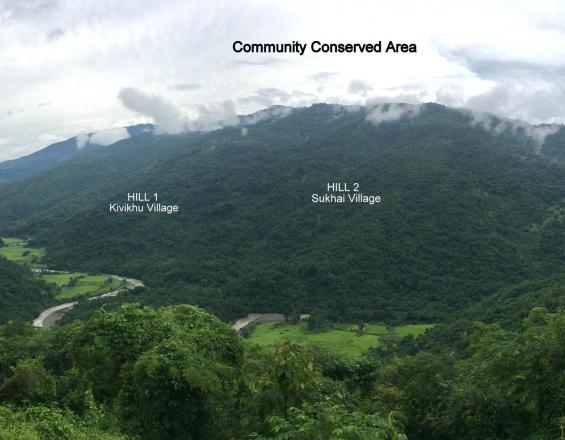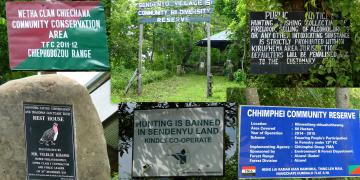Siddharth Edake is a Fellow and Area Convener for the Centre for Biodiversity and Ecosystem Services at The Energy and Resources Institute (TERI), India, which won the 2021 Pathfinder Award for its PANORAMA Solution - 'Strengthening community conservation in a biodiversity hotspot'.
What makes your solution successful in a nutshell?
The management and strengthening of community conserved areas is a solution that is ‘of the people…by the people and for the people!
This is a traditional form of conservation, which has been documented since the 1800’s, where various tribes and sub-tribes in Nagaland set aside a certain parcel of land- it can be a forest, river etc and the motivation to do so also varies. It can be a source of water, a breeding ground for wildlife etc
However, with modernization and lack of alternate livelihood options, this connect with nature seemed to be slightly dwindling. So TERI, on the request of the communities in three villages of Sukhai, Kivikhu and Ghukhuiye in Zunheboto district of Nagaland, acted as a catalyst and helped in rejuvenating this age old practice through community mobilization and building synergies. We assisted in rejuvenating and linking CCAs across the pilot landscape, sensitizing communities and garnering their support for conservation through livelihood creation.
This has led to joint governance of CCAs leading to landscape level conservation of large contiguous patches of forests, bigger protected corridors for wildlife movement, documentation of traditional indigenous knowledge that has been oral in nature and enhanced livelihood opportunities with the steady flow of tourists.
Last year, your organisation, TERI, won the Pathfinder Award for the category “Biodiversity Conservation”. In your perspective, how did the award benefit your organisation and the communities you’re working with?
The communities in Nagaland take lot of pride when their efforts are recognized. These are remote areas which hardly come into limelight given the vast and diverse country India is. This award has helped to boost the confidence of the Sumi communities with whom we work and motivate them to sustain their conservation efforts. It has also compelled the communities from neighboring villages that share their boundary and resources with the CCAs to join the network thus making it a people’s movement.
On policy aspect, it has once again brought the discussion on recognizing the CCAs at par with the Protected Area Network within the country that comprises of National Parks, Wildlife Sanctuaries and so on.
TERI has decided to handover the cash prize received under the Pathfinder Award to the communities which they inturn wish to use for appointing local youth as guards for better protection of their community forests. These locally appointed guards will not only patrol the areas, stop the outsiders from illegal hunting & fishing in the conservation area, but will also educate the masses through awareness programmes.
What is your vision for the Nagaland CCAs network?
The first-ever documentation conducted by my organization revealed that one third of the Nagaland’s villages (close to 407 villages) have constituted CCAs and as many as 82% of these 407 CCAs have completely or partially banned tree felling and/or hunting within the CCAs, and enforce various regulations for conservation. These CCAs covering more than 1700 sq km accounting to 18.5% of the total recorded forest area in the State, also contribute to carbon storage and are an important mitigation and adaptation strategy for climate change.
To ensure the future of Nagaland’s CCAs and thereby its biodiversity, the Government of Nagaland needs to pass a special policy to mainstream this model of biodiversity conservation within the governance mechanism and up-scaling it through a multi-pronged approach including financial support and legal recognition. Furthermore, local communities must be trained to monitor their resources, and to develop nature based tourism, which will help generate support for conservation.
Protected and Conserved Areas networks, local knowledge and alternative livelihoods, which are key elements of your solutions, are recognized and promoted by global organisations as critical for resilient vital sites and communities, which are living in and around them. From your experience on the ground, what messages or recommendations would you like to convey to them, in order to further support the work you and your peers are doing?
Always listen to the communities and try and execute actions that they have in mind.
Nurture local champions. Having local champions is key to give thrust to the initiative & for the communities to own it. This also leads to rapid spread of such conservation successes & sustained motivation.
Tapping into traditional knowledge and drawing upon the rich cultural traditions and biological heritage of local communities gives them a sense of pride in their heritage and enhances conservation outcomes.
Developing working, alternative conservation-linked livelihoods is the lifeline of conservation initiatives that incur financial burdens. Hence its important to find ways to identify such livelihoods.
Would you like to share a final word with us?
It has been interesting to observe how COVID-19 has impacted the CCA communities minimally. And the reason being, they are deeply connected with their environment, with nature, and don’t depend on what modernity has brought to the rest of the population.


